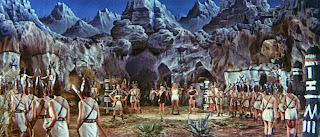Rock cliffs, gorges and chasm are usual topics on
matte painting. When
a matte artist spend around 40 years of his life paintings for films, is not
surprising that he have to
paint the
same subject repeatedly.
British matte painter Bob Cuff started at1952 in
Shepperton Studios under Wally Veevers, he latter worked for Les Bowie and then
formed the company Abacus productions with matte camera John Mackey.
He retired at 1989 after painting mattes for Eric the Viking.
During his long career, he had to execute some
spectacular paintings of cliffs for several well-known films.
The first time was for The Guns of Navarone (1962) Gregory Peck climbing at Shepperton
Studios surrounded by matte paintings. Bob Cuff was the main matte artists at
Shepperton with Ted Samuels.
Some years lather, the same art director from Navarone,
Geoffrey Drake, called Bob Cuff to take responsibility of the mattes for the
film MacKenna’s Gold (1969)
This time Bob Cuff shared the painting work with
Ray Caple and Joy Sheddon who after marring his son Paul, became Joy Cuff.
Again Gregory Peck had to undergo a dangerous vertical climbing.
The last one was for The princess bride (1987) This time was Cary Elwes who made a hand climbing on the cliffs of insanity. Painted by Bob Cuff and Doug Ferris, with John Grant as matte camera.





















































